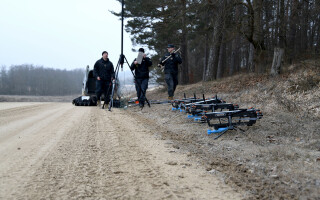UAS military market evolves beyond U.S.
StoryJuly 31, 2013
UAS platforms will be an important part of the nation's future defense strategy, but with the war in Afghanistan winding down, there is uncertainty regarding military UAS requirements.
Unmanned Aerial Systems (UASs) – also known as Unmanned Aerial Vehicles (UAVs), Remotely Piloted Aircraft (RPA), and drones – have been the fastest growing application in the U.S. arsenal during the past decade. They are still a key part of U.S. military strategy, but the U.S. defense market is shrinking or flat in many areas because of sequestration and large cuts to the Department of Defense’s budget. UAS platforms will be an important part of the nation’s future defense strategy, but with the war in Afghanistan winding down, there is uncertainty regarding military UAS requirements.
There are many UAS platforms coming home from the war such as image intelligence platforms and “we see an emphasis on repurposing them to justify their use in different environments,” says Chris Michalski, Technical Director, ISR at Mercury Systems in Chelmsford, MA. “For example, the Shadow UAS has traditionally been a camera platform so repositioning its payload with new defense electronics capabilities would enable the platform to extend its life and the government would get more return on its investment.”
UAS platforms and their payloads – ones with low classification levels – may also be repurposed for foreign military sales. U.S. UAS suppliers know their best bets for growth are global markets. General Atomics Aeronautical Systems, Inc. (GA-ASI) already has customers for its Predator B UAS in the United Kingdom and Italy and is working on a Predator B variant that can be sold to NATO foreign customers. In Europe the military and civilian UAS market is expected to be more than $17 million over the 2013-2021 period, according to ASD Reports.
However, the foreign market that might provide the best bet for American UAS developers over the next few years is the Middle East, as the area’s constant turmoil makes every nation want its own UAS fleet. The only obstacles they might face are U.S. export regulations and the Missile Technology Control Regime (MTCR) guidelines. The main competition for U.S. UAS manufacturers worldwide is Israel, but they are unlikely to do business with Arab nations.
“The U.S. seems to understand the strategic implications of not catering to the Middle East and may be considering options to bypass MTCR or amend existing norms in order to tap the Middle East market,” says Mahendran Arjunraja, Frost & Sullivan Aerospace & Defense Senior Analyst in a public release. “One way to bypass the MTCR is by providing [UAS] ‘services’ instead of selling the equipment. When [UAS] capability is rented, the ownership of the equipment still lies with the supplier country. The recent sale of ISR-only [UASs] – Predator drones – to UAE shows that the U.S. is willing to relax restrictions to grab market opportunities.”
Nonmilitary applications such as law enforcement and first responder applications are other growth areas. The U.S. is exploring these applications too, but interest differs from state to state and the rules for civilian aircraft are still developing. Currently to fly a UAS in U.S. civilian airspace, you have to ask for Federal Aviation Administration (FAA) permission and comply with rules such as only flying less than 400 feet high and maintaining a line of sight and staying more than 5 miles from the nearest airports.
“The proliferation of UASs in civilian airspace is getting very interesting,” says David Strong, VP of Marketing at FLIR Government Systems in Wilsonville, OR. “Civil use of UASs is potentially a huge market, but there [are] still not any clear rules or regulations governing them in that space. There is not a lot of clarity. Imagine all the applications that will spring forward if civilian communities were to embrace UAVs.”
In the U.S., UASs are not allowed for commercial use; only the government or FAA-approved law enforcement agencies may use them, but that fact doesn’t comfort everyone. In Deer Trail, CO, town officials are considering an ordinance that would allow for drone-hunting licenses, even offering $100 bounties for UASs, Amanda Kost of DenverChannel.com reports. She quotes the ordinance’s author, Phillip Steel, as saying: “We do not want drones in town. They fly in town, they get shot down.”
According to the story, the ordinance appears to be a reaction to government drones, but I wonder if Mr. Steel’s animosity toward unmanned aircraft would extend to civilian use as well. In the United Kingdom, a Domino’s franchise partnered with UAS maker AeroSight to deliver pizzas in an unmanned DomiCopter. According to a story on money.cnn.com, Domino’s officials in the U.S. denied any involvement in the publicity stunt and say they have no plans to initiate pizza drone delivery in the U.S. Good thing, as it might be dangerous in Deer Trail.
John McHale [email protected]





